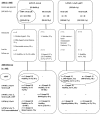Normocalcaemic, vitamin D-sufficient hyperparathyroidism - high prevalence and low morbidity in the general population: A long-term follow-up study, the WHO MONICA project, Gothenburg, Sweden
- PMID: 25988687
- PMCID: PMC4744766
- DOI: 10.1111/cen.12819
Normocalcaemic, vitamin D-sufficient hyperparathyroidism - high prevalence and low morbidity in the general population: A long-term follow-up study, the WHO MONICA project, Gothenburg, Sweden
Abstract
Objective: There is limited knowledge about the natural history of normocalcaemic, vitamin D-sufficient hyperparathyroidism (nHPT). The aim was to study the prevalence of nHPT and its relation to morbidity.
Design: Cross-sectional and retrospective study at the Sahlgrenska University Hospital, Gothenburg, Sweden.
Subjects: A random population of 608 men and women, age 25-64 years, was studied in 1995 as part of the WHO MONICA study and reinvestigated in 2008 (n = 410, of whom 277 were vitamin D sufficient).
Measurements: A serum intact parathyroid hormone (S-PTH) ≥60 ng/l was considered as HPT, S-calcium 2·15-2·49 mmol/l as normocalcaemia and S-25(OH)D ≥ 50 nmol/l as vitamin D sufficiency. Data on fractures, stroke and myocardial infarction were retrieved until 2013, that is a 17-year follow-up.
Results: The prevalence of nHPT was 2·0% in 1995 (age 25-64) and 11·0% in 2008 (age 38-79). S-PTH was positively correlated with age and BMI. After adjustment for these variables, a high S-PTH level (≥60 ng/l) at follow-up was associated with previously low S-25(OH)D, high osteocalcin, S-PTH and both past and presently treated hypertension. No relation was seen with creatinine, cystatin C, malabsorption markers, thyroid function, glucose, insulin, lipids, calcaneal quantitative ultrasound, fractures, myocardial infarction, stroke or death at follow-up.
Conclusions: This small random population study showed that nHPT was common, 11% at follow-up. Only one individual developed mild hypercalcaemia in 13 years. Previous S-PTH was predictive of nHPT and hypertension was prevalent, but no increase in hard end-points was seen over a 17-year period.
© 2015 The Authors. Clinical Endocrinology Published by John Wiley & Sons Ltd.
Figures


References
-
- Nussbaum, S.R. , Zahradnik, R.J. , Lavigne, J.R. et al (1987) Highly sensitive two‐site immunoradiometric assay of parathyrin, and its clinical utility in evaluating patients with hypercalcemia. Clinical Chemistry, 33, 1364–1367. - PubMed
-
- Eastell, R. , Brandi, M.L. , Costa, A.G. et al (2014) Diagnosis of asymptomatic primary hyperparathyroidism: proceedings of the fourth international workshop. Journal of Clinical Endocrinology & Metabolism, 99, 3570–3579. - PubMed
-
- Shlapack, M.A. & Rizvi, A.A. (2012) Normocalcemic primary hyperparathyroidism‐characteristics and clinical significance of an emerging entity. The American Journal of the Medical Science, 343, 163–166. - PubMed
Publication types
MeSH terms
Substances
LinkOut - more resources
Full Text Sources
Other Literature Sources
Medical
Research Materials
Miscellaneous

